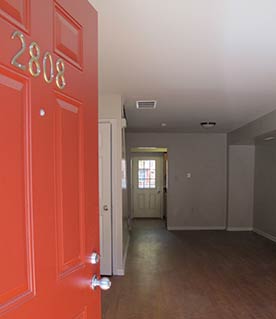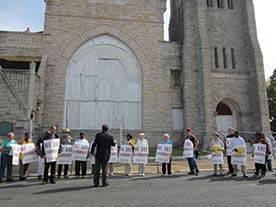
Photo by Ashley Hahn
The Adolfina Villanueva Townhouses stand in the shadow of a half-demolished burned-out husk of a former high school in Fairhill. This section of Eastern North Philadelphia is a predominantly Latino neighborhood that has suffered from decades of disinvestment, as well as high rates of crime and poverty. But this tidy cluster of townhouses developed in the 1990s by the Women’s Community Revitalization Project (WCRP) stands out as a bright spot where some of the neighborhood’s low-income women and their families can find quality affordable housing.
Not far away, in South Kensington, WCRP’s Johnnie Tillmon Townhouses are a bulwark of affordability as the neighborhood’s real estate market has started to simmer, bringing a new wave of market-rate developer and homebuyer interest.
WCRP, a place-based nonprofit that builds and manages affordable housing projects as part of its community development and advocacy work, built both Tillmon and Villanueva in the 1990s using federal affordable housing tax credits. And last spring it embarked on an ambitious housing preservation project to rehab all 77 two-, three-, and four-bedroom units at both sites using a fresh round of affordable housing tax credits.
This well-timed project is allowing WCRP to fix flaws in the original construction, improve energy-efficiency, and freshen up each unit with remodeled kitchens and bathrooms.
But this is about more than shiny new appliances and fresh coats of paint. WCRP’s housing work is an extension of its grassroots organizing and advocacy on behalf of low-income women and their families. By providing safe, welcoming housing they are offering these families a chance at a new future built through self-determination. By upgrading these 77 units, WCRP is trying to improve lives too.
If WCRP were a different sort of an organization, it might have considered just patching the holes or cashing in on a few units after the tax credits’ 15-year period of required affordability had expired. Instead, WCRP is reinvesting in this earlier generation of its affordable housing developments — one a bastion of quality in a tough neighborhood, the other a toehold of affordability in a sea of change.
In a way, it’s a chance for WCRP to take lessons it’s learned in 20-plus years of developing affordable housing and bring those back to improve these older units. In doing so, WCRP is reaffirming its long-term commitment to the women and their families who need good affordable housing options in these neighborhoods.
Time for an Affordable-Housing Overhaul
After 15-20 years, mounting maintenance demands, aging systems, and dated appliances meant it was time to do something to update these tired units. If not, keeping them up was going to become an increasingly expensive proposition for WCRP.
Over the years WCRP has worked to take advantage of funding opportunities to improve its housing stock. For example, all of the windows at Villanueva were replaced recently with more efficient models thanks to “Smart Rehab” funding from the Pennsylvania Housing Finance Agency. But that piecemeal approach only goes so far.
“We were finding ourselves doing a lot of roof repairs,” WCRP’s development team coordinator, Paul Aylesworth, explained. “We have maintenance reserves, but those won’t cover major system breakdowns.”
“For us the capital infusion came at exactly the right time,” Nora Lichtash, WCRP’s executive director, explained. “When you build something, even with the best reserves in the world, you need a capital infusion to keep them up and make sure that they reflect what’s new and the best construction methods and sustainability issues.”
In 2012, WCRP secured affordable housing tax credits from the Pennsylvania Housing Finance Agency to do rehabilitation work on the 77 units at Villanueva and Tillmon. They account for about 30 percent of WCRP’s rental portfolio.
Tillmon’s rehab was also motivated by a failing prefabricated stucco system on the rear walls. It was constructed without a way for moisture to escape, which led to a variety of problems, particularly around the windows and inside the walls.
“That’s something we’re really glad we can fix,” said Aylesworth.
Both complexes, renamed Tillmon-Villanueva as a result of the tax-credit project, will have new roofing systems. Each unit’s kitchen and bathroom will be remodeled with new cabinetry, flooring, and counter tops. New energy-efficient appliances and central air-conditioning will also be installed. In addition, the rear walls of Tillmon’s 23 units will be rebuilt.
The project is informing how WCRP thinks about its future development work, as well as what the organization might do differently along the way.
“I think it’s really influenced what we’re doing to maintain and upgrade our existing units,” Lichtash said, specifically an increased focus on energy-efficiency concerns and choosing durable materials, both of which help tenants and WCRP save money in the long run.
The $8 million construction budget for Tillmon-Villanueva comes principally through affordable housing tax credits, syndicated by National Equity Fund, with equity investment from TD Bank. WCRP also received $499,000 from the City of Philadelphia through a combination of sources, including Community Development Block Grant money, HOME, and the city’s Affordable Housing Trust Fund.
The Organizer-Developer
While the Tillmon-Villanueva project might sound like a conventional housing-preservation deal, WCRP is no typical developer.
Born out of community organizing in 1987, WCRP is deeply rooted in Eastern North Philadelphia neighborhoods. Its work — from political advocacy and housing development to supportive services and community and economic development — stems from values of access, equity, and inclusion.
Starting with the Adolfina Villanueva Townhouses, WCRP’s first tax-credit project, WCRP worked to find ways to make sure its units were within reach of the city’s truly low-income women. By taking a substantial portion of its developer’s fee for each project and investing it, WCRP was able to create an internal rent subsidy that corresponds to a tenant’s ability to pay. Rents can start as low as $92 per month and tenants will not pay more than 50 percent of their incomes on housing costs.
For the Tillmon-Villanueva project, Lichtash explained, “We have a million dollars invested to maintain affordability, and that’s long-term affordability.” The interest from the one million dollars invested (from both the previous investment and this new round of financing) is what covers the internal subsidy.
WCRP’s very structure is set up to be inclusive and blur the lines of power. Tenants and community members can become as involved as they wish in the organization’s committees and decision-making processes. Anyone can serve on a WCRP committee at any time, and after about a year of committee service individuals are eligible for orientation to the Advisory Committee, which makes decisions by modified consensus with WCRP’s board.
“People come from honestly different points of view and those points have to be presented,” Lichtash explained. So when important decisions are discussed, those various valid, sometimes divergent, viewpoints are discussed and often modified to reach agreement.
“If people are heard, usually you can get to an understanding,” Lichtash said.
Expertise comes in many forms and WCRP invites the knowledge and experience of the low-income women and families they work with to help shape their policies and influence the design of their developments. Their Housing Committee, made of community members and tenants, provides designers with meaningful feedback from the user’s perspective about housing floor plans and design.
Lichtash says that this high level of input is possible by being clear about participants’ roles and levels of influence, as well as setting real, reasonable expectations for each process. For example, decisions the Housing Committee makes about design finishes are final, while decisions about the tenant relocation process are shaped through feedback. Transparency, Lichtash has found, goes a long way.
Some tenants and community members may choose not to participate, but Lichtash said it’s not hard to find people interested in getting involved. In her experience Lichtash said “most women are hungry to have a role in decision making,” particularly pertaining to their own housing.
The Relocation Game
Given WCRP’s core values and organizational approach, it took on the Tillmon-Villanueva preservation project with as much sensitivity as possible to its tenants, who would need to be shuffled in and out of their homes in eight phases.
“It was like a big chess game,” Aylesworth described. WCRP started collecting its empty units and setting them aside as temporary housing in anticipation of the move.
Last May, WCRP started moving groups of tenants into its own temporary housing to make way for construction. After an average of 10 weeks people were able to move home again. As of May 2013, the project was in Phase 7, focusing on the Tillmon site at 4th and Master streets.
“The relocation part was going to be a pain in everyone’s neck and we knew it, but we wanted to have resources so that we could soften the negative effects,” Lichtash said.
WCRP worked with a relocation specialist to help coordinate each tenant’s move, from temporary changes of address to the movers and cleaning services.
“We put as much money as was allowed in the relocation budget and we said we are going to take care of our people,” Lichtash said. “Everything was paid for and there was a lot of support to help people understand the process, pack, store anything that couldn’t go into a temporary unit, and move back.”
Every tenant that chose to remain with WCRP moved into WCRP housing, and a majority of tenants moved back into their original units.
“It was great that all we had to do was pack . . . no lifting heavy boxes, no getting a van,” said Jacqueline Harris, a WCRP tenant at Villanueva for 12 years. WCRP, she said, was able to help her take care of “all of the little things about that could be so frustrating” about the move.
Harris said she especially appreciated that she was able to stay in the neighborhood, moving down the street temporarily as part of the first group in the great tenant shuffle.
The hassle of living out of boxes was made all worth it, Harris said, when she walked back into the apartment she shares with her 23-year-old daughter.
“It was like a brand new place, like moving into it for the first time,” Harris said.
Walk in to any of the new units and it feels as though they could be market-rate.
“It is truly a blessing,” Jacqueline Harris said of her renovated two-bedroom apartment. Harris is quick to add that she has always appreciated what she had living at Villanueva. Still, she’s willing to concede that her apartment needed updating after 12 years of living there.
Across Franklin Street from Harris, Elizabeth Moran was able to move into an accessible first-floor unit as a result of the rehab project. Moran, who has lived in WCRP housing for several years, lives with her granddaughter.
Speaking through WCRP case manager Haydee Amill, who served as my Spanish translator, Moran said she believes the new unit has even helped her health because it is easier to keep clean. Her first WCRP unit was a three-bedroom unit, but the carpet made her allergies worse and it was expensive for her. She particularly appreciates the accessible bathroom because it’s easier for her to clean and she’s happy to not have to negotiate a tub.
Moran also says that she’s noticed a difference in her utility costs because of the energy-efficiency upgrades WCRP made during construction. Energy efficiency is especially important because tenants are responsible for their own utility bills, Aylesworth explained. Many tenants have utility allowances, and every dollar counts.
When I visited Harris at home, it was a thick Philadelphia morning in late spring and she was enjoying the comfort of her new central air conditioning. It is by far her favorite feature of the rehabbed unit. But she says she also really likes the updated kitchen. “I just want to keep it the best. I just love it,” she said.
Harris has seen her share of hard times. She is a recovering drug addict who bounced between her mother’s house and a shelter with her daughter before finding her home with WCRP. The shelter, she said, helped her turn her life around and got her to apply for Section 8 housing. When she found the apartment with WCRP it was the day before her voucher would have expired.
“I’m glad it was this place. I was ready to take anything,” Harris recalled.
Harris does have one gripe: She’s starting miss the maintenance guys because she doesn’t see them around anymore. There’s nothing small to fix these days.
Committed to Affordability
All told, the Tillmon-Villanueva project has been a huge undertaking. For Lichtash and others at WCRP it was not a question of whether to renovate these units but how. And the value of their continued affordability was never in doubt.
In Fairhill, where the need for quality affordable housing remains high, Villanueva’s renovation affirms WCRP’s long-term commitment to the community. In rapidly appreciating South Kensington, Tillmon sits on the edge of the once-gritty-now-gentrified Northern Liberties. And as South Kensington changes, protecting sustained affordability takes on a new value.
“People really value their place [at Tillmon] and in the neighborhood and have a certain amount of pride in it,” Aylesworth said.
Lichtash acknowledged that the 23 units at Tillmon could have yielded a handsome profit for WCRP if they’d been sold off. But that site was hard-won for the organization, marking its first NIMBY battle, and resulted in some strong neighborhood ties forged in coalition advocating for better vacant land policies in the city.
“For us it wasn’t a hard decision even though it would have brought in a lot of income,” Lichtash said. “I think the issue of fighting displacement and making sure that the neighborhood stays diverse is such a high value to us that the other opportunities didn’t seem worth it.”
WCRP sees many applicants for its developments and maintains a waiting list to fill its vacancies. It recognizes how enormous the need is for quality and truly affordable housing for low-income families throughout Philadelphia. And WCRP has seen first-hand the difference that stability at home can make.
“Once people have housing that they can afford, that’s safe, that isn’t falling down, people make enormous changes in their lives,” Lichtash said. “Our tenants lease up and within four years their median income goes up 80 percent.” From there, lives can change course.
For Fatima Dubose, living at Tillmon for the last few years has provided stability for her and her four children, ages 5 to 12. “I used to be stressed out a lot, yelling at my kids when they didn’t even do anything,” Dubose said describing the strain on her family life because they had to move around a lot. “Right now it’s stable for us.”
Her three-bedroom unit has enough space for family time and a bit of privacy, and her kids like the quiet street.
For now Dubose is living in temporary housing, missing her neighbors a bit, and looking forward to coming home again.






Comments